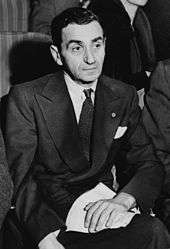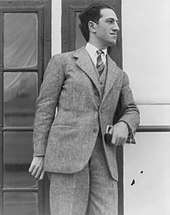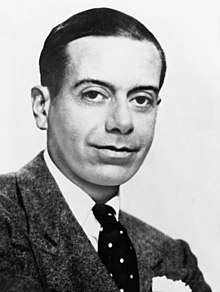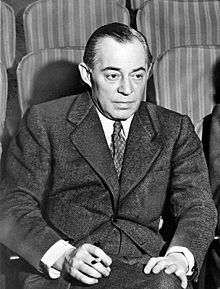Great American Songbook
The Great American Songbook is the canon of significant early-20th-century American jazz standards and popular songs.
Definition

According to the Great American Songbook Foundation:
The “Great American Songbook” is the canon of the most important and influential American popular songs and jazz standards from the early 20th century that have stood the test of time in their life and legacy. Often referred to as "American Standards", the songs published during the Golden Age of this genre include those popular and enduring tunes from the 1920s to the 1950s that were created for Broadway theatre, musical theatre, and Hollywood musical film.[1]
Martin Chilton of UDiscoverMusic.com defines the term "Great American Songbook" as follows: "Tunes of Broadway musical theatre, Hollywood movie musicals and Tin Pan Alley (the hub of songwriting that was the music publishers’ row on New York’s West 28th Street)". Chilton adds that these songs "became the core repertoire of jazz musicians" during the period that "stretched roughly from 1920 to 1960".[2]
Although several collections of music have been published under the "Great American Songbook" title, the term does not refer to any actual book or specific list of songs. The Great American Songbook includes standards by George Gershwin, Cole Porter, Irving Berlin, Jerome Kern, Harold Arlen, Johnny Mercer, and Richard Rodgers, among others.[3][4][5][6][7]
In Alec Wilder's 1972 study, American Popular Song: The Great Innovators, 1900–1950, the songwriter and critic lists and ranks the artists he believes belong to the Great American Songbook canon. A composer, Wilder emphasized analysis of composers and their creative efforts in this work.[8]
Radio personality and Songbook devotee Jonathan Schwartz has described this genre as "America's classical music".[9]
Songwriters and songs
The following writers and songs are often included in the Great American Songbook:

- Harold Arlen (with E.Y. Harburg):[10][5][6] "Over the Rainbow", "It's Only a Paper Moon"; with Ted Koehler: "Stormy Weather", "I've Got the World on a String", "I Gotta Right to Sing the Blues", "Let's Fall in Love"; with Johnny Mercer "Blues in the Night", "That Old Black Magic", "One for My Baby", "Come Rain or Come Shine", "Ac-Cent-Tchu-Ate the Positive"; and with Ira Gershwin "The Man that Got Away"
- Irving Berlin:[10][3][5][6][11] "Alexander's Ragtime Band", "When I Lost You", "How Deep Is the Ocean", "God Bless America", "White Christmas", "Always", "A Pretty Girl is Like a Melody", "Blue Skies", "Cheek to Cheek", "Puttin' on the Ritz", "Let's Face the Music and Dance", "There's No Business Like Show Business", "I've Got My Love to Keep Me Warm"
- Nacio Herb Brown with lyricist Arthur Freed:[12] "All I Do Is Dream of You", "Pagan Love Song", "Paradise", "Singin' in the Rain", "Temptation", "You Stepped Out of a Dream", "You Were Meant for Me", "Good Morning"
- Hoagy Carmichael:[11] "Stardust", "Georgia on My Mind", "Lazy River", "The Nearness of You", "Heart and Soul", "Skylark"
- Cy Coleman[13] (with lyrics by Carolyn Leigh): "Witchcraft", "The Best Is Yet to Come", "Hey, Look Me Over", "I've Got Your Number"; with lyrics by Dorothy Fields: "If My Friends Could See Me Now", "Big Spender"
- J. Fred Coots:[14] "Love Letters in the Sand", "Santa Claus is Coming to Town", "For All We Know", "You Go to My Head"
- Walter Donaldson, mostly with lyrics by Gus Kahn:[11] "My Baby Just Cares for Me", "My Blue Heaven", "Love Me or Leave Me", "Carolina in the Morning", "My Mammy", "What Can I Say After I Say I'm Sorry?", "Yes Sir, That's My Baby", "Makin' Whoopee", "You're Driving Me Crazy", "Little White Lies""
- Vernon Duke:[12] "April In Paris", "Autumn In New York", "I Can't Get Started", "Taking a Chance on Love"
- Duke Ellington:[13][6][11][15] "In a Sentimental Mood", "It Don't Mean a Thing (If It Ain't Got That Swing)", "Satin Doll" (with Billy Strayhorn and Johnny Mercer), "Mood Indigo", "Sophisticated Lady", "Take the 'A' Train", "I'm Beginning to See the Light", "Don't Get Around Much Anymore"
- Sammy Fain:[12] "I'll Be Seeing You", "That Old Feeling", "Love Is a Many-Splendored Thing", "April Love", "Tender is the Night"
- Dorothy Fields:[16] "I Can't Give You Anything But Love", "Exactly Like You", "On the Sunny Side of the Street", "A Fine Romance", "Pick Yourself Up", "The Way You Look Tonight", "Big Spender", "If My Friends Could See Me Now"
- George and Ira Gershwin:[10][3][5][6][7][15] "Someone to Watch Over Me", "'S Wonderful", "Summertime", "A Foggy Day", "But Not for Me", "Embraceable You", "I Got Rhythm", "Fascinating Rhythm", "The Man I Love", "They Can't Take That Away from Me", "Love Is Here to Stay", "Strike Up the Band"
- Ray Henderson:[17][18] "Alabamy Bound", "Bye Bye Blackbird", "I'm Sitting on Top of the World", "The Birth of the Blues", "The Best Things in Life Are Free", "Sonny Boy", "You're the Cream in My Coffee"
- Isham Jones with lyrics by Gus Kahn:[17][19][20] "It Had to Be You", "I'll See You in My Dreams"
- Jerome Kern:[5][10][6][7][15] "A Fine Romance", "Pick Yourself Up", "The Way You Look Tonight"; with lyrics by Ira Gershwin "Long Ago (and Far Away)"; with lyrics by Oscar Hammerstein II "All the Things You Are", "The Folks Who Live On the Hill", "Ol' Man River", "The Song Is You"; with lyrics by Otto Harbach "Smoke Gets in Your Eyes", "Yesterdays"
- Lerner and Loewe:[13] "Almost Like Being in Love", "On the Street Where You Live", "I Could Have Danced All Night", "I've Grown Accustomed to Her Face", "Thank Heaven for Little Girls"
- Frank Loesser:[21][15] "If I Were a Bell", "Slow Boat to China", "Standing on the Corner", "Baby, It's Cold Outside", "Luck Be a Lady"
- Jimmy McHugh:[12][16] "Don't Blame Me", "Exactly Like You", "I Can't Give You Anything But Love, Baby", "I'm in the Mood for Love", "On the Sunny Side of the Street"
- Johnny Mercer:[6][15] "On the Atchison, Topeka and the Santa Fe", "In the Cool, Cool, Cool of the Evening", "Moon River" with Henry Mancini, "Fools Rush In", and "Days of Wine and Roses"; wrote music and lyrics for "Dream", "Something's Gotta Give", and "I Wanna Be Around"; wrote lyrics for "Midnight Sun", "Day In, Day Out", "Laura" and "I Remember You"
- Cole Porter:[3][10][5][6][15] "Night and Day", "I've Got You Under My Skin", "Begin the Beguine", "Let's Do It, Let's Fall in Love", "What Is This Thing Called Love?", "Too Darn Hot", "Love for Sale", "You're the Top", "Just One of Those Things", "All of You", "I Get a Kick Out of You", "Ev'ry Time We Say Goodbye", "In the Still of the Night", "It's De-Lovely", "My Heart Belongs to Daddy", "I Concentrate on You", "You'd Be So Nice to Come Home To", "So in Love", "Anything Goes", "You Do Something to Me", “Miss Otis Regrets”
- Rodgers and Hart:[10][11][15][6][7] "Slaughter On 10th Avenue (ballet)", "Bewitched, Bothered and Bewildered", "With a Song in My Heart", "Falling In Love With Love", "My Romance", "Have You Met Miss Jones?", "My Funny Valentine", "Blue Moon", "Blue Room", "I Could Write a Book", "It's Easy To Remember", "It Never Entered My Mind", "Manhattan", "The Lady Is a Tramp", "Little Girl Blue", "Mimi", "My Heart Stood Still", "Spring Is Here", "A Ship Without a Sail", "Thou Swell", "Lover", "The Most Beautiful Girl in the World", "I Didn't Know What Time It Was", "Isn't It Romantic?", "Where or When", "Glad to Be Unhappy", "You Took Advantage of Me", "This Can't Be Love", "Mountain Greenery", "You Are Too Beautiful"
- Rodgers and Hammerstein:[10][15][6][7] "You'll Never Walk Alone", "Hello, Young Lovers", "Younger Than Springtime", "Oh What a Beautiful Mornin'", "People Will Say We're in Love", "It Might as Well Be Spring", "If I Loved You", "Happy Talk", "Some Enchanted Evening", "The Surrey with the Fringe on Top", "I Have Dreamed", "Shall We Dance?", "My Favorite Things", "Something Wonderful", "Climb Every Mountain", "Edelweiss", "I Enjoy Being a Girl", "The Sound of Music", "A Wonderful Guy"
- Harry Ruby and Bert Kalmar:[17] "Who's Sorry Now?", "Thinking of You", "I Wanna Be Loved by You", "Three Little Words", "Nevertheless", "A Kiss to Build a Dream On"
- Arthur Schwartz and Howard Dietz:[12][16] "Dancing in the Dark", "You and the Night and the Music", "I Guess I'll Have to Change My Plan", "Alone Together", "That's Entertainment!"
- Jule Styne:[17] "Time After Time", "Guess I'll Hang My Tears Out to Dry", "I Fall in Love Too Easily", "Diamonds Are a Girl's Best Friend", "Let It Snow! Let It Snow! Let It Snow!", "People", "Don't Rain on My Parade", "Just In Time", "Saturday Night (Is the Loneliest Night of the Week)", "The Party's Over", "Everything's Coming Up Roses"
- Jimmy Van Heusen, mostly with lyricists Johnny Burke and Sammy Cahn:[12] "All the Way", "Swinging on a Star", "Darn That Dream", "Polka Dots and Moonbeams", "But Beautiful", "Come Fly with Me", "Imagination", "Like Someone in Love", "Call Me Irresponsible", "I Thought About You", "Here's That Rainy Day", "It Could Happen to You", "(Love Is) The Tender Trap", "Ain't That a Kick in the Head"
- Fats Waller:[15] "Ain't Misbehavin'", "Honeysuckle Rose", "Squeeze Me"
- Harry Warren:[11][15][12] "At Last", "There Will Never Be Another You", "An Affair to Remember (Our Love Affair)", "I Had the Craziest Dream", "The More I See You", "42nd Street", "Boulevard of Broken Dreams", "Lullaby of Broadway", "You're Getting to Be a Habit with Me", "I Only Have Eyes for You", "Jeepers Creepers", "You Must Have Been a Beautiful Baby", "September in the Rain", "Lulu's Back In Town", "You're My Everything", "Chattanooga Choo Choo", "On the Atchison, Topeka and the Santa Fe", "This Heart of Mine", "You'll Never Know", "My Dream Is Yours", "Serenade In Blue", "Nagasaki", "(I've Got a Gal In) Kalamazoo", "That's Amore", "Innamorata"
- Richard A. Whiting:[11] "Till We Meet Again", "The Japanese Sandman", "Miss Brown to You", "He's Funny That Way", "Ain't We Got Fun", "Guilty", "Breezin' Along with the Breeze", "Ukulele Lady", "Honey (Rudy Vallée song)", "I Can't Escape from You", "Hooray for Hollywood", "Beyond the Blue Horizon", "On the Good Ship Lollipop", "Too Marvelous for Words"
- Jack Yellen, with Milton Ager:[17] "Ain't She Sweet", "Happy Days Are Here Again", "Big Bad Bill (Is Sweet William Now)", "Glad Rag Doll", "Hard Hearted Hannah (The Vamp of Savannah)", "Louisville Lou (That Vampin' Lady)"; with Lew Pollack, "My Yiddishe Momme"
- Vincent Youmans:[12] "Tea for Two", "Time on My Hands", "More Than You Know", "(The) Carioca", "Sometimes I'm Happy", "Without a Song", "I Want to Be Happy"
- Victor Young:[17] "I Don't Stand a Ghost of a Chance with You", "Stella by Starlight", "Love Letters", "My Foolish Heart", "When I Fall in Love", "Around the World"
Revivals
In 1970, rock musician Ringo Starr surprised the public by releasing an album of Songbook songs from the 1920s, 1930s, and 1940s, Sentimental Journey. Reviews were mostly poor or even disdainful,[22] but, being by a Beatle, the album reached #22 on the US charts[23] and #7 in Britain,[24] with sales of 500,000.[25]
It's a lot of songs that were my initiation to music. It's all the tracks that, when my mother and my father came home from the pub out [of] their heads, they'd sing all these songs.
— Ringo Starr[26]
Other pop singers who established themselves in the 1960s or later followed with albums reviving songs from the Great American Songbook, beginning with Harry Nilsson in 1973[27] and continuing into the 21st century.[A] Linda Ronstadt, Rod Stewart, and Bob Dylan made several such albums. Of Ronstadt's 1983 album, What's New, her first in a trilogy of standards albums recorded with arranger/conductor Nelson Riddle, Stephen Holden of The New York Times wrote:
What's New isn't the first album by a rock singer to pay tribute to the golden age of pop, but is ... the best and most serious attempt to rehabilitate an idea of pop that Beatlemania and the mass marketing of rock LPs for teen-agers undid in the mid-'60s. During the decade prior to Beatlemania, most of the great band singers and crooners of the '40s and '50s codified a half-century of American pop standards on dozens of albums, many of them now long out-of-print.[28]
See also
- Great American Songbook Foundation
- Traditional pop music
- Show tunes
- Lounge music
- Tin Pan Alley
- Songbook
Notes
- ^ Including Willie Nelson with Stardust (1978),[29] Dr. John with In a Sentimental Mood (1989),[30] Brian Wilson with Brian Wilson Reimagines Gershwin (2010),[31] Paul McCartney with Kisses on the Bottom (2012),[32] Bob Dylan with Shadows in the Night (2015),[33][34] Fallen Angels (2016),[35] and Triplicate (2017),[36] and James Taylor with American Standard (2020).[37]
References
- "A Great American Songbook Foundation". The Center For The Performing Arts.
- Chilton, Martin (April 3, 2020). "Cover To Cover: The Story Of The Great American Songbook | uDiscover".
- Miller, Michael (2008). The Complete Idiot's Guide to Music History. Penguin. p. 175.
- "The Center for the Performing Arts". The Center For The Performing Arts.
- "After An Education In American Jazz, A Musician Tackles The Turkish Songbook". NPR.org.
- Feinstein, Michael (February 11, 2015). "'The B Side,' by Ben Yagoda". The New York Times. Retrieved December 13, 2018.
- Friedwald, Will. "Jazz Vocalists". New York. June 14, 1993. p. 6A.
- Wilder, Alec (1990). American Popular Song: The Great Innovators 1900–1950. New York & Oxford: Oxford University Press. ISBN 0-19-501445-6.
- Deborah Grace Winer (September 1, 2003). "Girl Singers: From nightclubs and concert halls to recordings, today's best vocalists put a new spin on old favorites". Town & Country. Archived from the original on November 5, 2013. Retrieved September 9, 2012.(subscription required)
- Great Performances. "The Great American Songbook: Introduction". PBS. March 11, 2003.
- "The Great American Songbook". The Johnny Mercer Foundation. Retrieved December 20, 2018.
- Purdy, Stephen. Musical Theatre Song: A Comprehensive Course in Selection, Preparation, and Presentation for the Modern Performer. Bloomsbury Publishing, 2016. pt. 115.
- "The Great American Songbook – The Composers". Retrieved July 20, 2015.
- Cole, Clay (2009). Sh-Boom!: The Explosion of Rock 'n' Roll, 1953–1968. Morgan James Publishing.
- Purdy, Stephen. Musical Theatre Song: A Comprehensive Course in Selection, Preparation, and Presentation for the Modern Performer. Bloomsbury Publishing, 2016. pt. 32.
- Polit, Katherine. "The Great American Songbook In The Classical Voice Studio". Indiana University Jacobs School of Music. May 2014. p. 73.
- Murray, Steve. "Michael Feinstein: Crooners". CabaretScenes.org. May 23, 2017.
- Dicker, Shira. "Gotta Dance? Swing on Over". New York Times. December 22, 2011.
- Venutolo, Anthony. "Boardwalk Empire recap: 'Make a promise to you, break another to myself'". NJ.com. November 4, 2013.
- "The Great American Songbook – The Composers". HalLeonard.com. Retrieved December 20, 2018.
- James Hall (March 20, 2020). "Ringo Starr's Sentimental Journey: how an 'embarrassing' solo album helped doom the Beatles". The Telegraph. Retrieved July 22, 2020.
To many Beatles fans, Sentimental Journey was awkward... a novelty record. ...John Lennon dismissed it as 'embarrassing'. ...the critics maul[ed] it.
(subscription required) Robert Christgau. "Consumer Guide Album – Ringo Starr: Sentimental Journey [Apple, 1970]". Robertchristgau.com. Retrieved July 22, 2020.For over-fifties and Ringomaniacs: the reports that he did this collection of standards for his Mums are obviously true. C MINUS.
Shaffner, Nicholas (1980). The Boys From Liverpool. New York: Methuan. p. 162. ISBN 9780416306613. Retrieved July 22, 2020.Casting himself as the sort of Frank Sinatra-style singer his mother had always adored, Ringo recorded Sentimental Journey, an album of songs from the twenties, thirties, and forties. This was the last thing Beatlemaniacs wished to hear...
Greil Marcus (May 14, 1970). "Ringo Starr". Rolling Stone. Archived from the original on August 28, 2018. Retrieved July 22, 2020.Sentimental Journey may be horrendous, but at least it's classy. Or is it?
Georgiy Starostin. "Ringo Starr". The Tower of Babel. Retrieved July 22, 2020.A horrendous bunch of Hollywood tunes - the biggest imaginable blow to a Beatles' reputation. What an odd record to represent the very first true post-Beatles collection of material by any solo Beatle... the record is so grotesquely ridiculous that it isn't even pukey.
Jacob Shelton (March 27, 2020). "Ringo Starr Releases His First Ever Solo Album in 1970: How Did That Go?". Groovy History. Retrieved July 22, 2020.[Sentimental Journey] received scathing reviews. Starr’s singing was mocked as was the maudlin tone of the album.
- "Chart History: Ringo Starr". Billboard. Retrieved July 22, 2020.
- "Ringo Starr". Official Charts. Retrieved July 22, 2020.
- Nick Deriso (March 27, 2015). "Why Ringo Starr Began His Solo Career With 'Sentimental Journey'". Ultimate Classic Rock. Townsquare Media. Retrieved July 22, 2020.
- James Hall (March 20, 2020). "Ringo Starr's Sentimental Journey: how an 'embarrassing' solo album helped doom the Beatles". The Telegraph. Retrieved July 22, 2020.(subscription required)
- Ruhlmann, William. "A Little Touch of Schmilsson in the Night". AllMusic.
- Stephen Holden; Dargis, Manohla (September 4, 1983). "Linda Ronstadt Celebrates The Golden Age of Pop". The New York Times. Retrieved May 10, 2007.(subscription required)
- Deusner, Stephen (August 15, 2008). "Willie Nelson Stardust: Legacy Edition". Pitchfork Media. Pitchfork Media Inc. Retrieved November 21, 2011.
- "Dr. John: In a Sentimental Mood". Allmusic. allmusic.com. Retrieved April 12, 2016.
- "Brian Wilson Reimagines Gershwin by Brian Wilson" – via www.metacritic.com.
- Hermes, Will (February 7, 2012). "Kisses on the Bottom | Album Reviews". Rolling Stone. Retrieved April 1, 2012.
- Turner, Gustavo (January 24, 2015). "The secret Sinatra past of Bob Dylan's new album". Los Angeles Times. Retrieved February 20, 2017.
- Petridis, Alexis (January 29, 2015). "Shadows in the Night review – an unalloyed pleasure". The Guardian. Retrieved February 20, 2017.
- Brown, Helen (May 13, 2016). "Bob Dylan, Fallen Angels, review -'inhabiting classics with weathered ease'". The Daily Telegraph. Retrieved February 20, 2017.
- "Bob Dylan's First Three-Disc Album — Triplicate — Set For March 31 Release". bobdylan.com. January 31, 2017. Archived from the original on February 1, 2017. Retrieved February 20, 2017.
- Monger, Timothy. "James Taylor – American Standard". AllMusic.
Further reading
- Bloom, Ken (2005). The American Songbook: The Singers, the Songwriters, and the Songs. New York: Black Dog & Levental Publishers. ISBN 1-579-12448-8.
- Furia, Philip (1992). Poets of Tin Pan Alley. New York & Oxford: Oxford University Press. ISBN 0-195-07473-4.
- Furia, Philip (2006). (with Michael Lasser) America's Songs: The Stories Behind the Songs of Broadway, Hollywood, and Tin Pan Alley. Routledge. ISBN 0415990521.
- Furia, Philip (2010). (with Laurie Patterson) The Songs of Hollywood. New York & Oxford: Oxford University Press. ISBN 0195337085.
- Furia, Philip (2015). (with Laurie Patterson) The American Song Book: The Tin Pan Alley Era. New York & Oxford: Oxford University Press. ISBN 0199391882.
- Morath, Max (2002). The NPR Curious Listener's Guide to Popular Standards. Penguin-Perigee Trade. ISBN 978-0-399-52744-9.
- Yagoda, Ben (2015). The B-Side: The Death of Tin Pan Alley and the Rebirth of the Great American Song. New York: Riverhead Books. ISBN 1-594-48849-5.
- Zinsser, William (2001). Easy to Remember: The Great American Songwriters and Their Songs. Boston: David R. Godine. ISBN 1-567-92147-7.
External links
- The Great American Songbook Foundation
- The Society for the Preservation of the Great American Songbook
- The American Songbook Preservation Society
- Popular Songwriters and The Great American Songbook
- PBS Special on the Great American Songbook
- Martini in the Morning radio program featuring the Great American Songbook


